The $60 CPU Question: AMD Athlon 200GE or Intel Pentium Gold G5400? A Review
by Ian Cutress on January 14, 2019 8:00 AM ESTCPU Performance: Office Tests
The Office test suite is designed to focus around more industry standard tests that focus on office workflows, system meetings, some synthetics, but we also bundle compiler performance in with this section. For users that have to evaluate hardware in general, these are usually the benchmarks that most consider.
All of our benchmark results can also be found in our benchmark engine, Bench.
PCMark 10: Industry Standard System Profiler
Futuremark, now known as UL, has developed benchmarks that have become industry standards for around two decades. The latest complete system test suite is PCMark 10, upgrading over PCMark 8 with updated tests and more OpenCL invested into use cases such as video streaming.
PCMark splits its scores into about 14 different areas, including application startup, web, spreadsheets, photo editing, rendering, video conferencing, and physics. We post all of these numbers in our benchmark database, Bench, however the key metric for the review is the overall score.

As an all-around test, one hopes that PCMark should be able to shine a light into this analysis. The end result is that PCMark says Intel should be ahead by around 8%.
Chromium Compile: Windows VC++ Compile of Chrome 56
A large number of AnandTech readers are software engineers, looking at how the hardware they use performs. While compiling a Linux kernel is ‘standard’ for the reviewers who often compile, our test is a little more varied – we are using the windows instructions to compile Chrome, specifically a Chrome 56 build from March 2017, as that was when we built the test. Google quite handily gives instructions on how to compile with Windows, along with a 400k file download for the repo.
In our test, using Google’s instructions, we use the MSVC compiler and ninja developer tools to manage the compile. As you may expect, the benchmark is variably threaded, with a mix of DRAM requirements that benefit from faster caches. Data procured in our test is the time taken for the compile, which we convert into compiles per day.
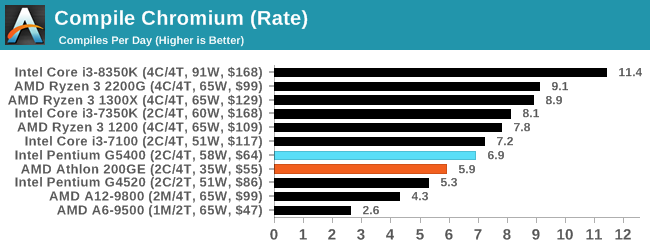
I like this Chromium test, given that it probes a lot of areas within a system. The Intel G5400 wins here again, scoring 6.9 compiles per day, compared to 5.9 for the AMD 200GE.
3DMark Physics: In-Game Physics Compute
Alongside PCMark is 3DMark, Futuremark’s (UL’s) gaming test suite. Each gaming tests consists of one or two GPU heavy scenes, along with a physics test that is indicative of when the test was written and the platform it is aimed at. The main overriding tests, in order of complexity, are Ice Storm, Cloud Gate, Sky Diver, Fire Strike, and Time Spy.
Some of the subtests offer variants, such as Ice Storm Unlimited, which is aimed at mobile platforms with an off-screen rendering, or Fire Strike Ultra which is aimed at high-end 4K systems with lots of the added features turned on. Time Spy also currently has an AVX-512 mode (which we may be using in the future).
For our tests, we report in Bench the results from every physics test, but for the sake of the review we keep it to the most demanding of each scene: Cloud Gate, Sky Diver, Fire Strike Ultra, and Time Spy.
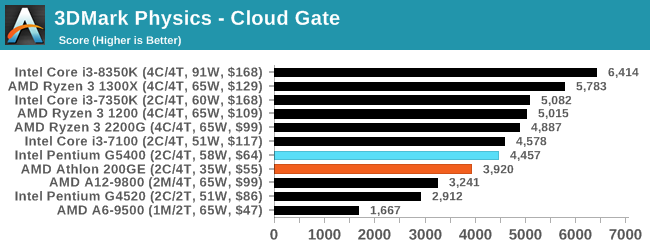
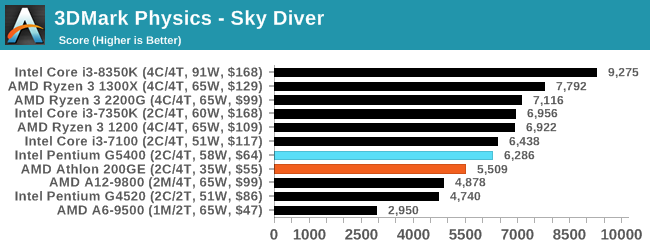
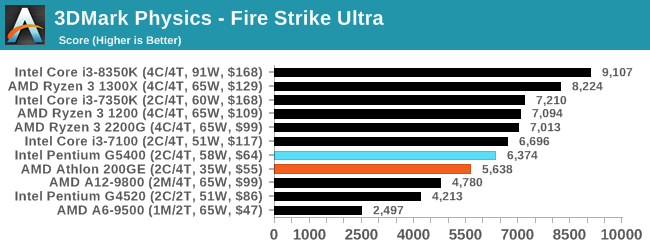
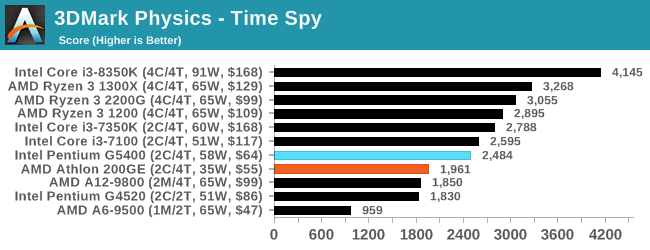
In all the tests except Time Spy, Intel takes an 11-12% lead over AMD, while in Time Spy that increases to 20%.
GeekBench4: Synthetics
A common tool for cross-platform testing between mobile, PC, and Mac, GeekBench 4 is an ultimate exercise in synthetic testing across a range of algorithms looking for peak throughput. Tests include encryption, compression, fast Fourier transform, memory operations, n-body physics, matrix operations, histogram manipulation, and HTML parsing.
I’m including this test due to popular demand, although the results do come across as overly synthetic, and a lot of users often put a lot of weight behind the test due to the fact that it is compiled across different platforms (although with different compilers).
We record the main subtest scores (Crypto, Integer, Floating Point, Memory) in our benchmark database, but for the review we post the overall single and multi-threaded results.
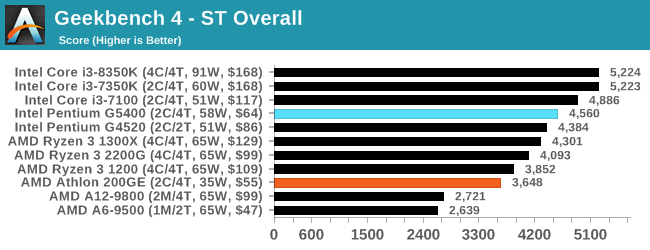
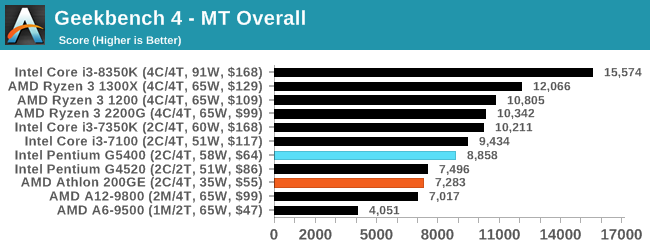










95 Comments
View All Comments
mczak - Monday, January 14, 2019 - link
Yes, I'd expect at least the Athlon to be quite close to its TDP with simultaneous CPU+IGP load.The Pentium probably not really (although the Pentium G5500/G5600 could get close, as these have the GT2 (UHD 630) rather than the GT1 (UHD 610) graphics, which also should be much more competitive with the Athlon).
biiiipy - Monday, January 14, 2019 - link
In my country the cheapest I can find is 200GE for 50€ andG5400 for 90€... yeah...ET - Monday, January 14, 2019 - link
Very nice to see a low end comparison, and a quite comprehensive one at that.What I don't understand is why quite a few benchmarks (especially on the IGP tests) are missing some of the CPUs.
Rudde - Monday, January 14, 2019 - link
The test setup table doesn't include the G5400.shabby - Monday, January 14, 2019 - link
The g5400 is $183 on amazon...T1beriu - Monday, January 14, 2019 - link
You should have measured the power consumption for 100% CPU load + 100% GPU load, lile POV + Furmark?Flunk - Monday, January 14, 2019 - link
These are close enough that I would buy whichever I could get cheaper (with a compatible board of course).Targon - Monday, January 14, 2019 - link
Of course, if you are looking to start low but then upgrade later, socket AM4 will allow upgrades from the lowest end to top end.edzieba - Tuesday, January 15, 2019 - link
So could the Pentium, right to the 9900k.eastcoast_pete - Monday, January 14, 2019 - link
@Ian: thanks, and I agree with your conclusion, but only if the ~$60 mark is a hard upper limit. Take-home for me: if you believe that you're going to be working and gaming on the iGPU of the chip even for a few months, try as hard as you can to get the extra $40 and buy the Ryzen 2200 G instead, which retails for $99 or so. That is still the value king here, and by a big margin. Unlike either the Pentium or the Athlon, the 4 cores and the (much beefier) iGPU of the 2200G can provide the 25-30 frames/second in many of the games tested here, has generally superior performance on non-gaming applications as well, and, once the dedicated graphics card arrives, it still gives a better showing than either Athlon or Pentium. Plus, as Gavin here and others on their sites have shown, there is significant headroom left for overclocking if that extra 10% or so is a must-have. So, long in short: For a budget system, and if at all possible, get the Ryzen 2200G. It is well worth the 40 bucks more.